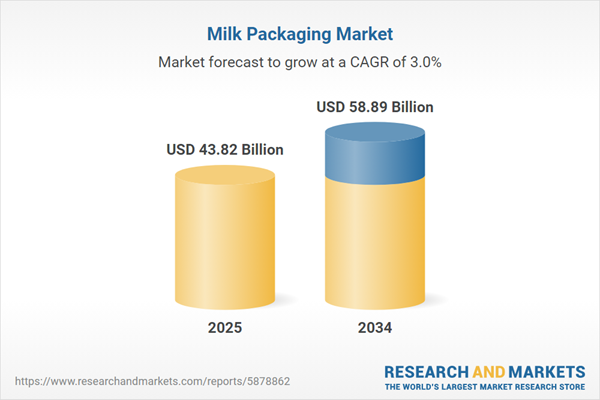During the forecast period of 2025-2034, the Asia-Pacific market is likely to experience relatively rapid revenue growth, as several developing countries, such as India and China, account for a significant production and consumption of milk.
Plastic is a significant segment of the milk packaging market in terms of material. It will also be the most optimistically growing material segment of the market in the next few years. Paperboards are also expected to grow significantly in the near future due to the increasing penetration of technological developments in the food and beverage packaging market worldwide.
In the Asia-Pacific, different developing nations like India and China are the biggest milk producers and consumers in the region. Overall economic growth and heavy investment from key producers in the region would probably make the Asia-Pacific a dominant player in the industry in the coming years. The prevalence of a dense population and the increase in innovations in the industry contribute to the growth factors for this area. North America and Europe are the other significant markets for the product after the Asia-Pacific as their contribution to milk production and consumption is relatively lower than in the Asia-Pacific.
People in the Asia-Pacific region are typically tolerant of products that contain lactose, which creates new lactose-free avenues. Also, increasing concerns about child nutrition will complement dairy consumption and, thus, boost the market. In the region, the dairy trade is the primary source of income for many farmers, with the highest growth expected in the sector over the forecast period. There is a significant difference in supply and demand in countries such as India, despite being responsible for over 15% percent of global milk production. Even under these unfavourable conditions, the Indian government has decided to continue banning the imports of milk and milk products. It is supporting local farmers in large part in increasing their yield. The government also encourages foreign companies to develop domestic production. It is common in several other nations in the Asia-Pacific, such as China. Thus, the focus on increasing milk production is expected to drive the growth of the milk packaging market in the region.
Global Milk Packaging Market Segmentation
Packaging is a method used to secure, transport, identify and permit product merchandising using containers and components, and should be made from materials that are most suitable for this purpose. In addition to enabling safe and hygienic product packaging, a company can distinguish its products from those of its competitors.On the basis of type, the milk packaging market is divided into:
- Cans
- Bottles
- Pouches
- Cups
- Others
Based on material, the market is segmented into:
- Glass
- Plastic
- Metal
- Paperboard
The regional markets for milk packaging include:
- North America
- Europe
- Asia-Pacific
- Latin America
- Middle East and Africa
Global Milk Packaging Market Analysis
Factors like the growing number of small households through which consumers prefer to serve single packages of consumer products are driving the development of the global milk packaging market, especially for milk and other milk products. In addition, the demand for milk as a source of calcium, minerals, vitamin D, and protein in different countries by a growing number of health-conscious consumers is adding to the growth of the industry. The availability of various flavoured milk products in the market is another factor that is expected to fuel the global industry growth over the forecast period. Therefore, a growing population and disposable per capita income are expected to lead to future profits of packaged dairy products. Besides, different milk applications in the preparation of food products are projected to drive the growth of the milk packaging market in the coming years.Nevertheless, price fluctuations of the products used in milk packaging (aluminium, plastics, paper) can slightly impede milk packaging sales. The major developments in the global market for milk packaging towards environmentally friendly products are, however, expected to aid the industry growth in the coming years. The paperboard segment is, thus, likely to drive the maximum growth in the near future, among other kinds of materials used for milk packaging due to its recyclable properties.
Competitive Landscape
The report gives a detailed analysis of the following key players in the global milk packaging market, covering their competitive landscape, capacity, and latest developments like mergers, acquisitions, and investments, expansions of capacity, and plant turnarounds:- Amcor plc
- Industrial Development Company sal
- Stanpac Inc.
- Graham Packaging Company Inc
- Crown Holdings
- Others
Table of Contents
Companies Mentioned
The key companies featured in this Milk Packaging market report include:- Amcor plc
- Industrial Development Company sal
- Stanpac Inc.
- Graham Packaging Company Inc
- Crown Holdings
Table Information
| Report Attribute | Details |
|---|---|
| No. of Pages | 167 |
| Published | August 2025 |
| Forecast Period | 2025 - 2034 |
| Estimated Market Value ( USD | $ 43.82 Billion |
| Forecasted Market Value ( USD | $ 58.89 Billion |
| Compound Annual Growth Rate | 3.0% |
| Regions Covered | Global |
| No. of Companies Mentioned | 6 |









